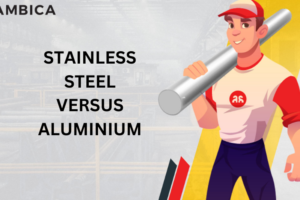Stainless steel is a metal alloy used for over a century. It is the most requisite and widely used in a vast array of equipment from the kitchen to aerospace. Its applications are engineered in such a way that stainless steel equipment has become essential in households and food processing industries. Recently, Food Processing, Food Packaging, and Beverage Manufacturing companies are opting for food-grade stainless steel.
Food regulation guidelines issued specific requirements for stainless steel to be food grade. Food-grade stainless steel should be resistant to heat and possess considerable wear-tear resistance. It is safe to cook any food in food-grade stainless steel cookware.
Stainless steel is used in the food industry
Stainless steel is an amalgamation of iron, carbon, and chromium. Chromium is the key element that makes stainless steel corrosion-free. Stainless steel is the best choice for the food industry. It is food-grade, corrosion-free, hygienic, and durable. These qualities make it supremely surrounded by food industries globally. Stainless steel offers corrosion resistance and pitting resistance and holds good in processing environments.
BENEFITS OF USING STAINLESS STEEL.
- Corrosion resistance
Stainless steel is resistant to corrosion and is commonly used in kitchen equipment.
- Durability
Stainless steel has considerable strength which makes it a better choice in heavy-duty equipment in various applications. It is less prone to any physical damage and can be maintained for a longer period.
- Heat resistance
Stainless steel can undergo high temperatures and ideal for cookware in household and commercial kitchens. Stainless steel cookware is safe even at a high temperature. No contamination is reported at even high temperature while cooking.
- Sanitation
Steel surfaces are smooth and sturdy. It is easy to maintain hygiene and sterilized. Cleaning agents can be used without causing harm to its surface.
- Non-reactive nature.
Stainless steel is non-reactive to acids present in food. It is neutral to flavor agents present in food items. It even does not affect the taste, color, and smell. Even does not impart any deleterious effect on food while cooking.
- Chemical-resistant
Bleaches and other surface cleaners can be used while cleaning.
- Aesthetic appeal.
- Recyclable in nature
Stainless steel is recyclable and environmentally friendly. It can be recycled without losing its properties.
GRADE SELECTION
Various stainless steel grades are available today. Grades are assigned to stainless steel based on their compositions. For measuring food-grade quality, it is essential to look for sanitation, durability, temperature resistance, and non-reactivity of the metal. Stainless steel grades should be safe for food preparation, storage, and dining; essential requirements for food equipment.
The most common food grades are 316 stainless steel, 304 stainless steel, and 430 stainless steel.
It is an austenitic grade of stainless steel, characterized by the presence of molybdenum, chromium, and nickel. It is well suited for foods because 316 offer high resistance to corrosion in acids and chlorides.
It is an austenitic grade. It contains chromium and nickel. 304 is the most commonly used grade. It can easily withstand corrosion, durable, and easy to sterilize. 304 stainless steel is commonly used in milk processing and wine-making.
-
430 stainless steel
It is a ferritic alloy with low nickel composition. It has a high tolerance to acidic foods and shows resistance to oxidation and sulfurs.
APPLICATIONS OF STAINLESS STEEL
- Commonly used in Stainless steel cutlery, Cook tops, Steel sinks, Modular kitchens, Dishwashers, and built-in cooking products.
- Stainless steel is widely used in the manufacturing of food processing equipment such as hot water lines, transportation, and storage.
- Stainless steel is commercially used in Food presentation equipment like display racks, cake stands, etc.
- Beverage manufacturing companies utilize stainless steel in processing and packaging. Steel cans are a recent trend as it can be recycled.
To conclude, food-grade stainless steel is the safest selection in recent times. It is a great alternative option to Teflon coated aluminum coated cookware. Awareness is promoting stainless steel in the food industry progressively. Stainless steel is safe, 100% recyclable, and has supreme sustainability.




